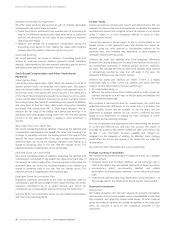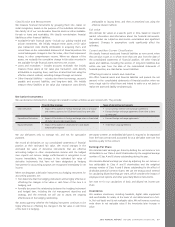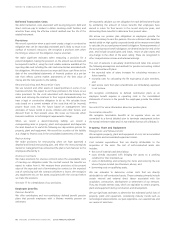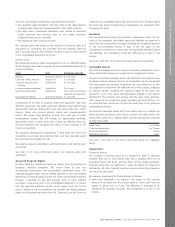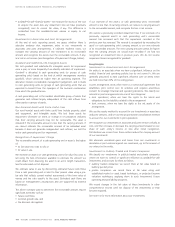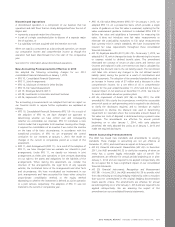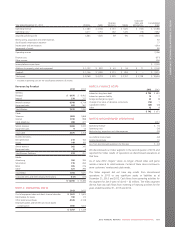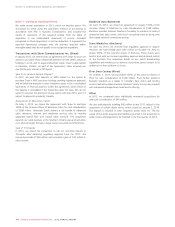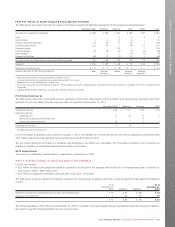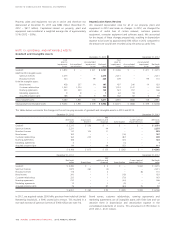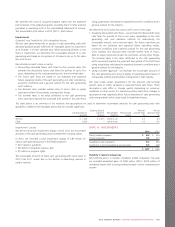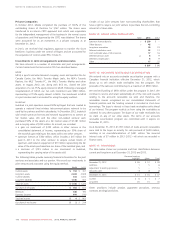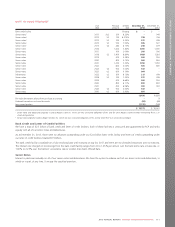Rogers 2013 Annual Report Download - page 106
Download and view the complete annual report
Please find page 106 of the 2013 Rogers annual report below. You can navigate through the pages in the report by either clicking on the pages listed below, or by using the keyword search tool below to find specific information within the annual report.
NOTES TO CONSOLIDATED FINANCIAL STATEMENTS
•IFRIC 21, Levies (IFRIC 21) – In May 2013, the IASB issued IFRIC 21,
which provides guidance on when to recognise a liability for a levy
imposed by a government, both for levies that are accounted for in
accordance with IAS 37 Provisions, Contingent Liabilities and
Contingent Assets and those where the timing and amount of the
levy is certain. The Interpretation identifies the obligating event for
the recognition of a liability as the activity that triggers the payment
of the levy in accordance with the relevant legislation. It provides the
following guidance on recognition of a liability to pay levies (i) the
liability is recognised progressively if the obligating event occurs over
a period of time, and (ii) if an obligation is triggered on reaching a
minimum threshold, the liability is recognised when that minimum
threshold is reached. The standard is effective for annual periods
beginning on or after January 1, 2014, with early adoption
permitted. We are assessing the impact of this new standard on our
consolidated financial statements.
•IFRS 9, Financial Instruments (IFRS 9) – The IASB issued IFRS 9, which
replaces IAS 39, Financial Instruments: Recognition and
Measurement, establishes principles for the financial reporting of
financial assets and financial liabilities that will present relevant and
useful information to users of financial statements for their
assessment of the amounts, timing and uncertainty of an entity’s
future cash flows. This new standard also includes a new general
hedge accounting standard which will align hedge accounting more
closely with risk management. It does not fundamentally change the
types of hedging relationships or the requirement to measure and
recognize ineffectiveness, however it will provide more hedging
strategies that are used for risk management to qualify for hedge
accounting and introduce more judgment to assess the effectiveness
of a hedging relationship. The IASB has not yet communicated the
mandatory effective date of IFRS 9. We are assessing the impact of
this new standard on our consolidated financial statements.
NOTE 3: SEGMENTED INFORMATION
Our reportable segments are Wireless, Cable, Business Solutions and
Media. All four segments operate substantially in Canada. Corporate
items and eliminations includes our interests in businesses that are not
reportable operating segments, corporate administrative functions and
eliminations of inter-segment revenue and costs. We follow the same
accounting policies for our segments as those described in note 2 to
these consolidated financial statements. Segment results include items
directly attributable to a segment as well as those that can be allocated
on a reasonable basis. We account for transactions between reportable
segments in the same way we account for transactions with external
parties and eliminate them on consolidation.
The Chief Executive Officer and Chief Financial Officer are the chief
operating decision makers and regularly review our operations and
performance by segment. They review adjusted operating profit as a
key measure of performance for each segment and to make decisions
about the allocation of resources. Adjusted operating profit is income
before restructuring, acquisition and other expenses, stock-based
compensation expense, depreciation and amortization, impairment of
assets, finance costs, other income, and income taxes. This measure of
segment operating results is different from operating income on the
consolidated statements of income.
Information by Segment
Year ended December 31, 2013 Wireless Cable
Business
Solutions Media
Corporate
items and
eliminations
Consolidated
totals
Operating revenue $ 7,270 $ 3,475 $ 374 $ 1,704 $ (117) $ 12,706
Operating costs 14,113 1,757 268 1,543 32 7,713
Adjusted operating profit 3,157 1,718 106 161 (149) 4,993
Restructuring, acquisition and other expenses 85
Stock-based compensation expense 184
Depreciation and amortization 1,898
Operating income 2,926
Finance costs (742)
Other income 81
Income before income taxes $ 2,265
Additions to property, plant and equipment $ 865 $ 1,105 $ 107 $ 79 $ 84 $ 2,240
Goodwill $ 1,146 $ 1,256 $ 426 $ 923 $ – $ 3,751
Total assets $ 9,775 $ 5,527 $ 1,195 $ 2,247 $ 4,857 $ 23,601
1Included in operating costs on the consolidated statements of income.
102 ROGERS COMMUNICATIONS INC. 2013 ANNUAL REPORT






